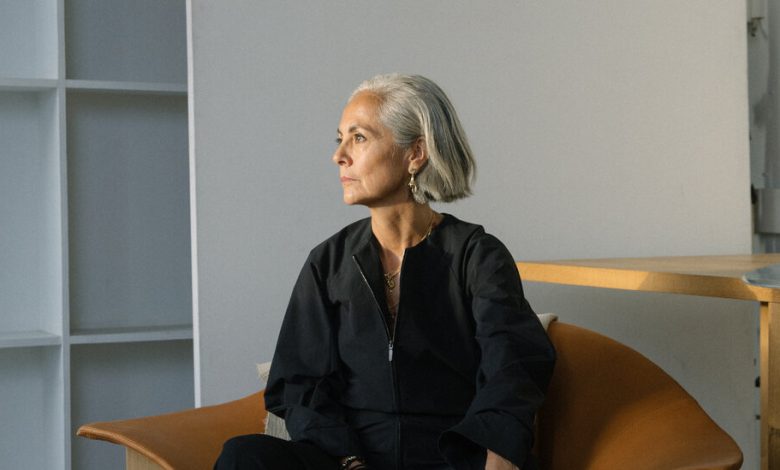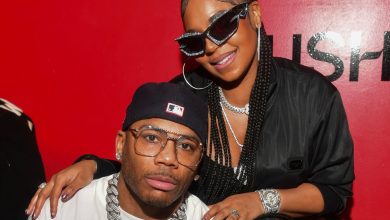The Survivor

Maria Cornejo, the Chilean American designer, got the call in June. She was at home in her sort of messy little white house in Brooklyn, she said, with her 18-year-old cat, Ziggy, and some very large ficus plants.
Steven Kolb, the chief executive of the Council of Fashion Designers of America, was on the line, telling her she was getting the lifetime achievement award from the CFDA. Given that, in the 25 years since she had opened her first store, she had never even been nominated for a CFDA award, not to mention won one — not women’s wear designer of the year or accessories designer of the year or emerging designer of the year, nothing — she was a little surprised. She had not, she said, been holding her breath.
After all, as the artist Cindy Sherman, a longtime customer, said: “She’s never even kissed up to Anna Wintour.”
Ms. Cornejo has stayed away from trends and paid celebrity ambassadors. Never advertised, never sold her name in return for investment. Never made a dress intended for a eye-catching picture rather than an actual person. Never done all the things designers are now expected to do as they become so-called creative directors, and fashion brands become content providers in the realm of globe-straddling entertainment.
What exactly, Ms. Cornejo wondered, was she getting the award for? Proving you could refuse to play the game and still survive?
At a moment when there is a lot of discussion in the fashion world (and outside of it) about why there aren’t more female designers at the top of big houses — when the recent choice of Kering, the industry’s second largest fashion conglomerate, to replace the Alexander McQueen designer, Sarah Burton, with Seán McGirr, meant that all of its creative directors were white men, setting off a fit of industry recrimination — Ms. Cornejo is a reminder that there is a model of a different kind.

Ms. Cornejo at the CFDA ceremony, where she was presented with a lifetime achievement award, wearing a suit and asymmetric tunic from her own line.Credit…via BFA Images
As she said in her CFDA acceptance speech, as she stood under the great blue whale in the American Museum of Natural History in front of her peers, and Kim Kardashian and Gwyneth Paltrow, despite all the times “I wanted to give up,” she wanted even less to be a cog in a machine, forced to dance to the TikTok demands of a marketing juggernaut.
“I never meant to be a rebel,” Ms. Cornejo had said in an interview a few days before the award ceremony. “It was more just doing my stuff in a quiet way that I believed was best. I’m quite stubborn. I wanted to make wearable clothes that would feel good, but I didn’t want boring mom clothes. The goal was to have a great collection, be able to pay everybody on time. Pay myself. Be home to see my kids. And have a vacation every once in a while.”
She is, by that measure, a great success. Michelle Obama wore her clothes when she was first lady and invited her to be part of a fashion workshop at the White House. Her customers also include the actresses Tilda Swinton and Laura Linney, and the model-turned-activist Christy Turlington. Ms. Cornejo and her business partner, Marysia Woroniecka, own the company.
In 2021, her work was part of “In America: A Lexicon of Fashion,” a show at the Metropolitan Museum. In 2006, she received a Cooper Hewitt National Design Award. Of all the interesting, edgy designers who emerged to great buzz in New York in the late 1990s, including Katayone Adeli and Daryl Kerrigan, Ms. Cornejo is the only one really left standing. Most of the rest have disappeared or shrunk to practical invisibility.
But Ms. Cornejo has also “had Covid, had cancer, got divorced,” she said. “Became a grandmother.” And according to Ms. Woroniecka, while “we’ve still got our nose above the parapet,” it’s not by a lot.
So what the current crop of women peppering New York Fashion Week — they include Rachel Comey, Hillary Taymour of Collina Strada, Elena Velez, Batsheva Hay and Carly Marks of Puppets & Puppets — want to know, Ms. Comey said, is: “How’d she keep it going?”
That story is either a riposte to the status quo or a cautionary tale. Maybe both.
‘When I’m dead and gone’
“I mean, sure I would like to do something like Chanel one day, but I also just always wanted to do my thing,” Ms. Cornejo, 61, said recently.
She was in her Manhattan showroom, which was separated from her shop by temporary drywall, tucked away on a not particularly hip stretch of Bleecker Street between Lafayette and the Bowery. Her silvery bob was tucked into a French twist, and she wore one of her signature jumpsuits, making her look like a swallow dressed up like a very chic grease monkey.
Upstairs was a rabbit warren composed of her office, pattern making room and studio, with bolts of fabric crammed against one side. If the store was a minimalist’s haven of white walls, tree stump stools and greenery, the backroom was its id.
“I always said, ‘Do I want to be remembered for being a good mom or great designer?’” Ms. Cornejo said. “When I’m dead and gone, I want my children to remember me more than anyone else.”
There was a time when Ms. Cornejo was poised to be the next big thing. This was after she graduated from Ravensbourne College of Design and Communication in England, where her family had settled after fleeing Chile under Pinochet. She was 12 when she arrived in London with her parents and three siblings; none of the kids spoke English.
The family eventually relocated to Manchester, and her mother, who had been a creative director of a publishing company in Chile, ended up cleaning hotel rooms. She died when Ms. Cornejo was 14, and Maria essentially raised her two younger siblings with her father until she went to college.
While in art school, Ms. Cornejo had started dating a fellow designer named John Richmond, and they created a line together, Richmond/Cornejo, which was licensed by the Japanese company Epoch Three. By the time she was 23, they had 20 stores in Japan, and Naomi Campbell, age 15, had walked in their runway show. But after three years, they split up and she decided to take a step back. She had never really enjoyed the limelight, and the stress had made her bulimic.
Ms. Cornejo, then 25, moved to Paris to live with her new boyfriend, the photographer Mark Borthwick, and started working behind the scenes on the design teams of mass-market brands like Jigsaw. She and Mr. Borthwick got married, she got pregnant with their daughter, Bibi, and at one point, she said, “My assistant said to me, ‘Do you realize that you spend more time with me than your husband and your child?’”
When Mr. Borthwick said he had to move to New York for work, she decided to try something new. She found an old garage space on Mott Street in Little Italy and opened a design-focused store called Zero that happened to include some clothes she made.
“It was starting from scratch,” Ms. Cornejo said. “I wanted it to be about the product, not about what I looked like or what I did. That’s why I called it Zero.” It opened in 1998, on the day her second child, her son Joey, was 8 months old.
‘It’s like being in a club’
“I had three sample makers in the back,” Ms. Cornejo said of Zero. “People used to come in, and if they liked the clothes, then we made some more. I could control how much I made, what I sold.”
She was buying deadstock, locally sourced, which made her sustainable before the industry even really knew the word existed. She didn’t consider what she was doing fashion as much as design, playing around with asymmetry and geometric ways of cutting — circles and triangles — to make shapes that curved around the body. Pants and shift dresses that could be shrugged on after a shower draped like evening wear. She was looking for a new way to make patterns, rather than looking to the past.
“I hate vintage,” Ms. Cornejo said. “It reminds me of sifting through piles of musty clothes when we came to the U.K.”
Garments she designs can look like schmattas until you put them on. “Women would come out of the changing room, look at themselves in the mirror and be transfixed,” said Molly Nutter, the president of By George in Austin, Texas, who began stocking Ms. Cornejo’s work when she was a buyer for Barneys New York.
Cindy Sherman was one of those women. A friend had suggested that she check out the Zero store. (It became Zero + Maria Cornejo after Ms. Woroniecka joined and they discovered there was already a brand in Germany called Zero.) “It was really hard to tell what anything looked like hanging up,” Ms. Sherman said. “But when I started trying things on, it was mind-blowing.”
She began going back again and again. Now, she said: “I buy, like, 10 things at a time. I always recognize when someone I know — usually someone in the arts — is wearing one of her pieces. It’s like being in a club.” She once admitted to owning about 200 pieces from Ms. Cornejo.
“You get a lot of attitude without a lot of aggravation,” said Nicole Phelps, the director of Vogue Runway, who has been wearing Ms. Cornejo’s clothes since she started covering her for style.com 20 years ago. “Her language is completely her own.”
Amale Andraos, a professor at the Columbia Graduate School of Architecture, Planning and Preservation and a founder of the architecture firm WORKac, said she started wearing Zero in 2002 when she moved to New York and pretty quickly decided to wear only that. “It’s just a very intelligent way to be feminine,” she said. She became friends with Ms. Cornejo and helped design the Bleecker Street store, when the brand relocated in 2009.
For a while, Ms. Cornejo was backed by Onward Kashiyama, a Japanese apparel company, and was planning an expansion that involved a store in most major cities, with a few multibrand wholesale partners.
By 2005, when Ms. Woroniecka, 67, whom Ms. Cornejo had known since she was in England, came onboard as president and a 50-50 partner, the business had been reduced to “a pattern/sample maker, one intern/assistant, one person working in the store and me,” Ms. Woroniecka said. “And yeah, the kitchen was in the bathroom. And you know, the meetings in the showroom were by the garbage cans.”
Losing the Fear
At first, Sept. 11 seemed like the worst thing that could happen, but it turned out to be just the beginning.
“There were lots of hard moments,” Ms. Woroniecka said. “Obviously 2008. Barneys going bankrupt — that was 25 percent of our wholesale revenue. Covid was a big one.”
It wasn’t only Covid, either: Just before the pandemic, she and Mr. Borthwick, who had photographed all the Zero collections and worked out of their brownstone, separated after more than three decades together. Then, in short order, Ms. Cornejo moved, got Covid and then got breast cancer. (It was caught early, and she is now cancer free.) “Stuff happens all the time,” she said, “but this time all the stuff happened at once.”
When the pandemic hit, she said, “I thought ‘OK, we’re going out of business.’” Then she herself got the virus. “I was on my own,” she said. “New York was really scary, and you could hear the ambulances day and night.” She decided to stay home and nurse herself. “I’d rather be in my own bed than somewhere where people are panicking,” she said. “It was quite liberating to lose that fear.”
Through it all, she had her job. “When I was going through my divorce, my work was the one thing that kept me from falling apart,” she said. “I look at myself in the mirror now, and sometimes I don’t even recognize myself, but in my work I know who I am.”
(She and Mr. Borthwick recently collaborated for the first time since splitting up, on her 25th-anniversary book, which features her fan group as models — her son, Joey; Chloë Sevigny; Brooke Williams of the Resistance Revival Chorus; the 74-year-old photographer Francesca Sorrenti.)
“The one thing you can do as an independent business is that you can make decisions quickly,” Ms. Cornejo said. “The thing that I loved about having a store is that you get instant feedback. You don’t have to wait a year. You actually have a true connection to your client.”
Maybe that’s why she still lurks around the back of the shop, coming out to talk to her customers and make recommendations. At this point, Zero + Maria Cornejo is stocked in about 50 stores worldwide (40 in the United States). She still makes about 85 percent of the collection in New York, about 70 percent of it from sustainable materials.
She moved to the Bedford Stuyvesant neighborhood of Brooklyn after her divorce, when she and Mr. Borthwick sold their family home in Cobble Hill. Her daughter, 32, lives in England and has a young child; her son, 26, is a creative director in London.
“Most of the time I’m eating dinner on my own at home,” Ms. Cornejo said. She likes cooking and is partial to colorful food combinations, like sweet potato, tomato sauce and kale.
She does not have a Hamptons place, a boat, a quazillion white orchids in her showroom or any of the trappings often associated with famous designers on Instagram. She does not even have a car. She is in the middle of her third attempt to get her driver’s license. (“I failed miserably,” she said. “I don’t test well.”) She does have a giant space in the Brooklyn Navy Yards, where she has finally begun storing her archives.
“Maria was always herself,” Ms. Woroniecka said. “She was never the lite version of someone else.”
That was both a strength — it gave her clarity and identity — and, perhaps, why she never got snatched up to head a great European house with much fanfare (though generally a short tenure), or became the sort of brand that was acquired by a larger company. The only thing she regrets, she said, is that she didn’t make enough money to be able to spread the wealth around to other women through a foundation. She had to settle for making clothes that make them feel, as Ms. Andraos, the architect, said, “we’re in this together.”
Ms. Cornejo is mostly OK with that. “I got to do it my way,” she said. “There’s not a lot of people who can say that.”
Still, she continued: “Whenever I talk to young designers, I say, ‘Guys, make sure this is really what you want.’ Because it’s a big sacrifice. It’s a lifetime. You really have to be sure.”



